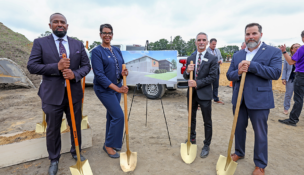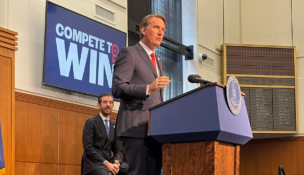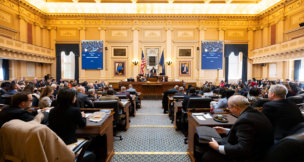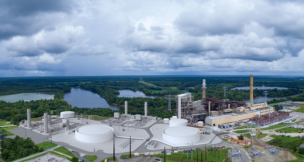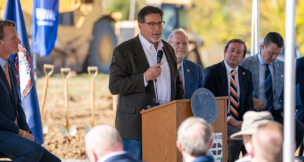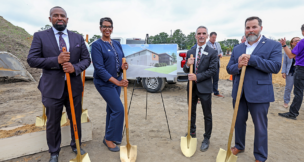Tilting toward windmills
Siemens Gamesa positions region as offshore wind hub
Tilting toward windmills
Siemens Gamesa positions region as offshore wind hub
Siemens Gamesa Renewable Energy S.A.’s October 2021 announcement that it will build the nation’s first offshore-wind blade factory at Portsmouth Marine Terminal has put Hampton Roads on a trajectory to become a supply chain hub for the country’s nascent offshore wind energy industry.
The Spanish wind turbine company is investing $200 million to build the factory, including more than $80 million to construct buildings and install equipment on an 80-acre leased site at PMT. Upon completion, the factory will be able to produce patented Siemens Gamesa Offshore IntegralBlades for 100 wind turbines annually.
That includes providing blades for the 176 turbines Dominion Energy Inc. will erect in federal waters 27 miles off the Virginia Beach coast for its 2.6-gigawatt, $9.8 billion Coastal Virginia Offshore Wind project. When completed in 2026, the CVOW project will be the United States’ largest offshore wind farm, powering up to 660,000 homes with clean, renewable energy.
Siemens Gamesa is partnering with Dominion on the offshore wind farm, and the blade factory will be up and running in time to support deliveries to the project. Additionally, about 50 of the 310 jobs planned at the factory will be service technician roles to support the CVOW farm. Dominion also is leasing 72 acres at the 287-acre terminal to stage and preassemble the foundations and 800-foot-tall wind turbines.
The combination of PMT’s facilities, proximity to the CVOW project and state incentives for site improvements factored into Siemens Gamesa’s decision to come to Virginia, says Steve Dayney, the company’s head of North American offshore wind operations. “Siemens Gamesa carefully considered all options for U.S. blade localization. Virginia moved swiftly to create a positive environment focused on spurring development of offshore wind in a competitive market.”
Dayney adds that the blade facility is the first step in developing PMT into an offshore wind hub. “We believe a local supply chain is the right choice for offshore wind in the U.S.” he says. “The establishment of a blade manufacturing facility is a major investment. Siemens Gamesa will look to potentially expand the facility if awarded future projects in the region and create additional jobs in the future.”
State and local officials have enthusiastically touted Hampton Roads as the ideal supply chain hub for the offshore wind industry. “Hampton Roads has incredible advantages for offshore wind,” says Jennifer Palestrant, former chief deputy for the Virginia Department of Energy and director of offshore wind. As she points out, the region boasts a deep, wide harbor free of air-draft restrictions from bridges and other overhead structures, not to mention an abundance of waterfront industrial sites with lay-down room for the large components used in wind projects.
Plus, she adds, the local maritime workforce is second to none. “People ask me what we do well here in Hampton Roads, and I tell them large-scale maritime steel.”
About 90% of the skills required to work in offshore wind are comparable to those in other local maritime industries such as shipbuilding. To maximize those skills, the state last year launched training programs at Virginia Beach’s Centura College, Norfolk’s Mid-Atlantic Maritime Academy and Martinsville’s New College Institute, all of which provide wind-related training courses certified by the Global Wind Organisation. Community colleges and universities also offer similar courses.
“We have been working to get our workforce ready for offshore wind,” says Palestrant, who was recognized by the Business Network for Offshore Wind’s Ventus Awards in December 2021 for her workforce training work. (Palestrant left the Virginia Department of Energy in January and the state was seeking a new offshore wind director in early February.)
Other wind energy companies are also looking to establish operations in Hampton Roads. “Siemens Gamesa is a tier-one supplier, but there about 6,000 pieces in a wind turbine,” Palestrant notes. “We look forward to Siemens Gamesa being our big first player and attracting other tier-one suppliers and lots and lots of tier-two and -three suppliers. We don’t often see opportunities like this.”
Dominion also expects its $500 million, 472-foot wind component installation vessel, Charybdis, to help establish Hampton Roads as a supply chain hub. The nation’s first offshore wind vessel built in compliance with the Jones Act, which requires goods shipped between U.S. ports to be carried aboard American-built ships, Charybdis will be homeported in Hampton Roads when it enters service in 2023.
“It starts to create a domestic supply chain that can serve nationally,” says Dominion media relations representative Jeremy Slayton. “It will maximize local economic development opportunities.” ν
n

